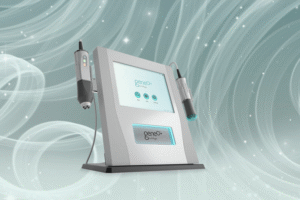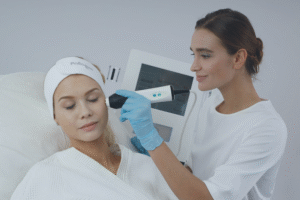
What Is an Oxygeneo Machine? A magic noninvasive 3-in-1 skincare device
While the oxygeneo machine has gained popularity in aesthetic clinics, many dermatologists and beauty specialists still question whether its oxygenation
More Posts

While the oxygeneo machine has gained popularity in aesthetic clinics, many dermatologists and beauty specialists still question whether its oxygenation

In a city like Dubai, where medical aesthetics are tightly regulated, inconsistency in post-treatment care can expose clinics to risk
Send Us A Message
The ergonomic design includes several aspects that contribute to improving the treatment experience and making it more effective and smooth. Among the most notable are:
These advanced technologies contribute to providing a comfortable and effective treatment experience for patients in addition to improving the dentist’s efficiency during medical procedures.
There are also several benefits to the electronic and hydraulic control system in orthodontic chairs, including:
Durability and quality are essential aspects in the design of orthodontic dental chairs as these characteristics are considered an indicator of the chair’s ability to withstand extensive use in dental clinics.
Highly durable chairs are characterized by their ability to remain in good condition over many years, which enhances the sustainability of the investment and the comfort of the dentist and patient during use.
Its most prominent characteristics are:
Made of durable materials such as stainless steel and aluminum that are guaranteed to withstand great pressure during long-term uses.
It is designed with a strong structure that can withstand many movements and repeated uses without affecting performance or comfort.
The chairs feature designs that provide high stability, which increases patient confidence and facilitates the dentist’s work during medical procedures.
Designed in a way that facilitates daily maintenance and cleaning, thus maintaining their cleanliness and quality throughout the period of use.
The design and production of orthodontic dental chairs undergoes stringent quality tests in accordance with global standards.
Many manufacturers offer long warranties on chairs, which reflects confidence in the quality of the product and its ability to perform excellently over the long term.
Chairs used in orthodontic treatments feature advanced technological equipment that enhances the efficiency of medical work and improves the patient’s experience in the clinic.
These technological features include advanced systems that facilitate diagnosis and treatment processes, making the chairs a vital tool in improving the quality of health care and patient comfort.
These features are of prominent importance in orthodontic chairs, including:
Electronic control systems represent an essential part of chair technology used in modern orthodontic treatments.
This technology allows precise control of chair positions and tilt angles, which facilitates the dentist’s work and enhances patient comfort during treatment sessions.
It has several benefits such as:
Integrated displays are a modern technology available in orthodontic dental chairs that contribute to improving patient experience and enhancing the efficiency of medical work. Dental chairs with screens are now the innovative trend in the modern dentistry.
These screens display important information such as dental images, charts, and treatment plans clearly and directly during treatment, which makes it easier for the dentist to explain the medical condition and interpret treatment plans to patients more effectively.
These screens have several benefits that play an important role in orthodontic chairs:
It helps enhance patient interaction by displaying clear images and a simplified explanation of his medical condition and treatment plans.
The patient is able to see the expected results and understand what is going on during the treatment session.
The dentist can use the monitors to clearly display dental images and X-rays.
This method simplifies instructions for patients and explains the options available to them during treatment.
The dentist’s ability to follow the development of the patient’s medical condition and precisely determine the necessary steps.
Lighting is one of the essential features of modern orthodontic chairs, as it provides precise and appropriate illumination of the mouth area during medical treatments. Dental chairs with lights provide a better illumination and a clearer vision of the working sight.
This technology is highly energy efficient and able to provide optimal lighting to help dentists see fine details and perform procedures with high precision.
Among its most important benefits are:
These tools form an essential part of the design of modern orthodontic dental chairs, as they help to providing greater comfort for the dentist and improving the patient’s experience during treatment sessions.
These tools are characterized by the ability to adjust chair positions easily and accurately, which helps in achieving excellent treatment results and providing distinguished health care.
Using hand or foot controls, chair height and tilt angles can be precisely adjusted to meet each patient’s needs. It is also used in orthodontics and oral surgeries to provide ideal working conditions.
These technologies include a set of characteristics and features that work to provide a comfortable and effective therapeutic environment, including:
They rely on a hydraulic system to control the height and position of the chair, which provides flexibility and ease of adjustment.
Electric motors are used to move and adjust the chair, allowing the dentist to adjust the position accurately and easily.
Suitable for mobile clinics or small spaces as they are lightweight and easy to transport.
provide additional support for the back and neck, which increases patient comfort during long sessions.
It is considered one of the leading chairs on the market, designed to provide ideal comfort and support for the patient.
It features advanced electronic and hydraulic control technologies, making it easier for dentists to adjust chair positions accurately and smoothly during treatments.
It is known for its durability and ability to withstand heavy daily use, making it a reliable choice for long-term clinics.
It has a design that provides superior patient comfort in addition to modern technologies such as advanced hydraulic control and various options for accessories.
It offers a comprehensive range of innovative technological features such as a precise and easy-to-use hydraulic control system.
It features advanced safety and a design that provides excellent patient support, making it an ideal choice for clinics seeking to combine high performance with comfort.
Note: These chairs represent just examples and there are many other options available on the market, each of which comes with unique features to suit the needs of different clinics and the preferences of dentists and patients.
Choosing the right orthodontic chair is an important decision for any dentist who wants to provide the best possible care for his or her patients.
Here are some factors to consider when choosing an orthodontic chair:
Note: Orthodontic chairs range in price from a few hundred dollars to several thousand dollars depending on features and brand.
Note: It takes into account the space occupied by the chair base, the rotation space of the chair, and the space of movement required for the dentist.
Note: Some features, such as electrical control and chair swivel capability, may be necessary for some patients while others, such as armrests and footplates, may be entertainment features only.
Consider your patients’ needs when choosing an orthodontic chair.
Note: Some patients may need chairs that provide additional support, such as chairs for children or chairs for patients with mobility problems.
The field of orthodontics is witnessing continuous development at all levels, including the design of orthodontic dental chairs. Here are some of the future trends we expect to see in orthodontic chair design:
Choosing the appropriate orthodontic chair is important to ensure patient comfort and efficient work in the clinic. Here are some tips that can help you choose the right chair:
Make sure the chair provides comfortable support for the patient’s back and neck. The design should be padded and adjustable to fit different body sizes and provide superior comfort during long treatments.
Choose a chair made of high-quality, durable materials that can withstand heavy daily use without being quickly corroded or damaged.
Check the technologies available in the chair, such as electronic and hydraulic control, light control systems, and built-in screens.
These features make it easier for the dentist to perform the treatment with precision and high efficiency.
The chair must be easy to use and adjust, so that the dentist and assistants can control its positions smoothly and easily during different treatments.
Choose a chair that is easy to clean and maintain with materials that resist stains and build-up to ensure a clean and safe environment in the clinic.
Ensure that the chair complies with international medical standards and holds the necessary certifications to ensure patient and client safety.
The chair must be cost-effective, as it fits within the clinic’s budget without sacrificing quality and performance.
Through our review of orthodontic dental chairs, we find that they are not just chairs, but rather technologically advanced tools designed to improve the patient experience and provide an ideal working environment for dentists.
These chairs are distinguished by their ergonomic designs and are equipped with the latest electronic and hydraulic technologies, which facilitates adjustment operations and ensures high accuracy in medical procedures.